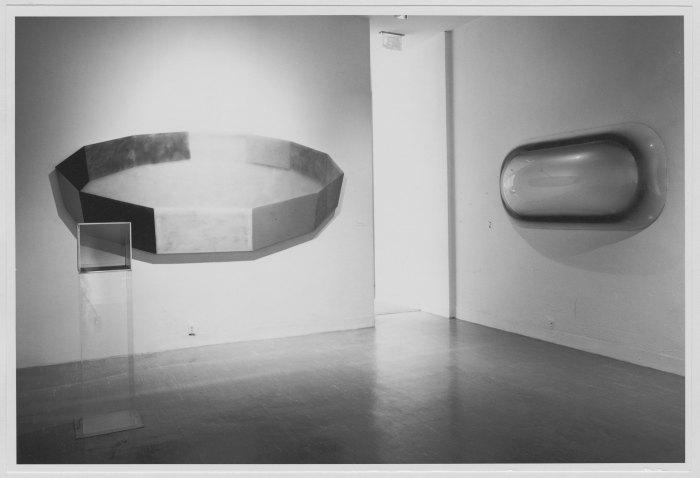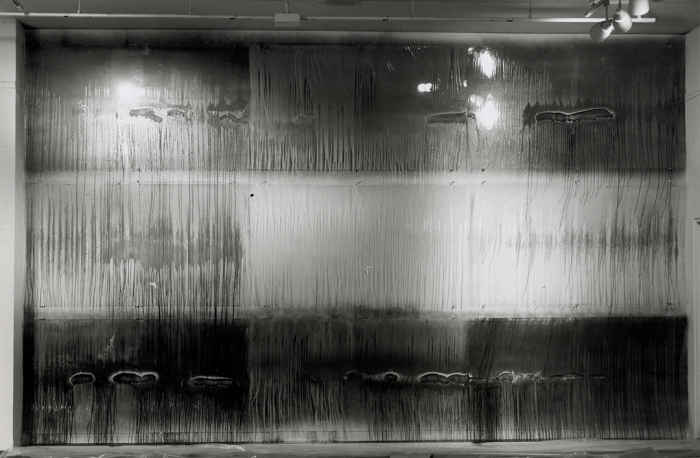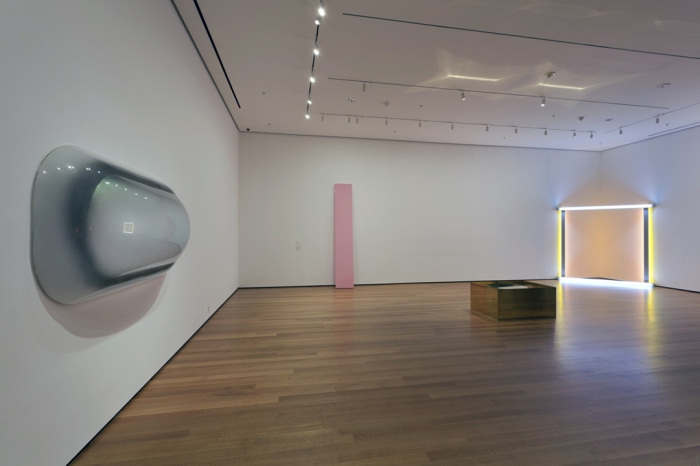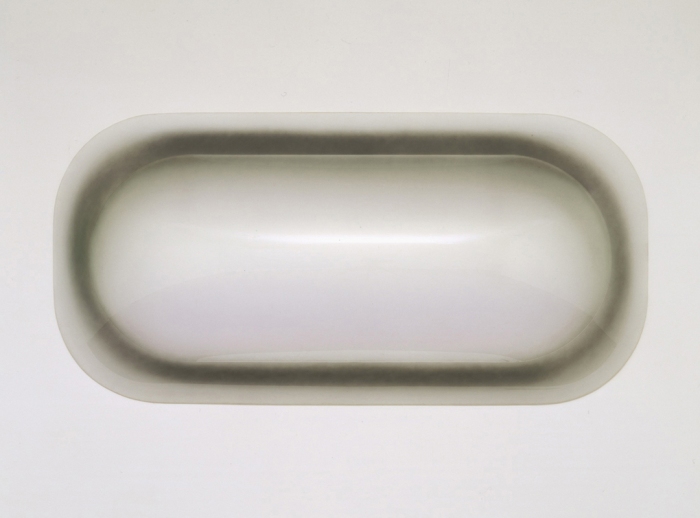Craig Kauffman’s Color
By 1971, Kauffman continued his interests in process art and forming plastic, but changed the way that the paint was applied, sometimes in a loose, uneven manner. Applied from the back, the color combination of green, yellow and red is reminiscent of the color of French painters like Matisse used after their travels. Kauffman stated, “I love colors in Mexico and Mexican buildings and all that stuff…and it mostly exists in my mind. I have never been to Mexico City. I have just been to Tijuana and Baja.” But Kauffman was also very much aware of how painters like Matisse were influenced, in a similar way, by the colors they saw in North Africa.
In an interview with Michael Auping, Kauffman recalled, “Well, I moved back out here [Laguna Beach] and then I went into forming those pieces that were only seen in Paris: some bars, and there were some that are like boards. They’re actually done over boards, put on sort of like the boards on a house around here…some of them were sprayed in sort of this uneven way. Then others were poured into this channel from the back.”

Illustrated:
Craig Kauffman Untitled, 1971
acrylic lacquer on press formed plastic
48 x 96 x 2 inches
Photography courtesy Sprüth Magers
Photo by Timo Ohler, copyright Estate of Craig Kauffman/Artists Rights Society ARS New York
Quotations from:
Auping, Michael. Los Angeles Art Community: Group Portrait. Craig Kauffman Oral History Program, University of California, Los Angeles, 1976.
Robert Morris and Craig Kauffman
Craig Kauffman and Robert Morris had a long friendship, dating back to April of 1958 when they both exhibited at the Dilexi Gallery, Opening Group Show, in the North Beach section of San Francisco. The two artists met up again several times, especially in New York during the late 1960s.
Their frequent discussions resulted in a short-lived collaboration for the exhibition Using Walls (Indoors) at the Jewish Museum in 1970, which remained open for only one day, and which Kauffman described as a combination of both of the artists’ ideas. Only a few years prior, Morris begun making process-oriented felt pieces, in which he hung strips of industrial felt on the wall and allowed gravity to determine their shape. This influenced Kauffman’s conception of his series of Loops, in which sheets of spray-painted Plexiglas seem to casually droop over a wire.
In Kauffman’s work, the environment constantly shifts as the viewer moves around each object. The light that moves across the curved edges of each piece facilitates the full comprehension of their forms. This draws comparisons to Morris’s own textual formulations in his influential Notes on Sculpture series, which advocated a phenomenological reading of the art object, how they change under varying conditions of light and space. The colored shadows of the hanging Loops and the cast plastic forms that project into space directly implicate both the viewer and their supports.


The photos above show the installation on the first floor of the exhibition curated by Frank Lloyd, Crossroads: Kauffman, Judd and Morris, Sprüth Magers London, January 19—March 31, 2018.
Installation views: Sprüth Magers, London, Crossroads: Kauffman, Judd and Morris, January 19–March 31, 2018.
Photo Courtesy Sprüth Magers
Photography by Stephen White
Craig Kauffman and Donald Judd
Craig Kauffman and Donald Judd met in the mid-1960s, when both had studios in Manhattan. They were friends and exchanged works, with Judd acquiring a 1967 translucent orange Plexiglas wall relief by Kauffman. Over the last 50 years, curators and critics have often noted the similarities in their use of industrial materials, serial imagery, with hybrid objects that present the relationship of sculpture and the wall.
Donald Judd used the phrase “specific objects” to describe his own work, a format which operated between painting and sculpture. Like the work of Judd, Kauffman’s three-dimensional plastic paintings occupy this liminal category. Their volume suggests that they are sculpture, but their presence on the wall reinforces their status as paintings. The unity of color and form, achieved through the use of industrial materials, is a point of similarity between the two artists’ objectives.
In the 2018 Sprüth Magers exhibit Crossroads: Kauffman, Judd and Morris, Donald Judd’s work was contextualized by the inclusion of the stack piece Untitled (Bernstein 80-4) (1980) and the floor piece Untitled, DSS 234 (1970). In the same ground floor room, curator Frank Lloyd placed the 1967 Craig Kauffman, which Judd had owned, along with a 1969 Kauffman Untitled Wall relief. Writing for Flash Art, critic Alex Bennet noted:
“Kauffman’s work on show demonstrates an unchallenged desire for phenomenological observation, a project of formal pleasure that distends from concerns of figure and ground, wall and support, industrial procedure and material contingency. The ground floor features Kauffman’s bulging biomorphic and bullishly lusty vacuum forms, shellacked and uniform like candies in chronic tangerine or extravagant duotone: ridged carnation pink protruding from a lacquered jade. Each one has its own resolute charm.”

Installation view: Sprüth Magers, London, Crossroads: Kauffman, Judd and Morris, January 19–March 31, 2018.
Larry Bell and Craig Kauffman
Over the past 60 years, Larry Bell and Craig Kauffman have appeared in 153 group exhibitions together. With similar concerns of transparency and luminosity, the artists also share an interest in the perceptual world of sensual phenomena.
Starting with the Los Angeles County Museum in 1959, and running through 2019, many of these shows were at museums. Curators from the 1960s such as John Coplans (Pasadena Art Museum) and Kynaston McShine (MOMA) were responsible for significant exhibits in the early years. In a legendary 1969 MOMA show by curator Kynaston McShine, Bell and Kauffman were shown with their friend and colleague Ron Davis, as well as Robert Irwin and John McCracken.
The Museum of Modern Art, New York, Five Recent Acquisitions, June 25–October 12, 1969. Organized by MoMA curator Kynaston McShine. Works by Larry Bell, Ron Davis, Robert Irwin, Craig Kauffman, and John McCracken.

Photo: Courtesy of Museum of Modern Art archives
Design Attitude
Ever since his high school days with his friend Walter Hopps, Kauffman was interested in jazz, often attending live concerts in the San Francisco Bay Area, including venues like the Burma Lounge. By 1952 Kauffman reunited with Walter Hopps at UCLA, and they joined up with another jazz enthusiast, Jim Newman, who was then attending Oberlin college. They joined others in forming a venture called Concert Hall Workshop. Their stated purpose was to promote jazz at public venues. With his architecture skills, Kauffman drew the plans for a future concert hall, and served as the graphic designer. Kauffman’s lively, bold designs for the programs are shown here. At this time, Kauffman said, “It was more of a Moholy-Nagy attitude, somewhere between design and architecture.”
Craig Kauffman also was a co-founder of Syndell Studios, along with Hopps, Newman, Ben and Betty Bartosh, Michael Scoles and Shirley Nielsen. Syndell Studios produced the legendary “Action 1: Concert Hall Workshop presents Action Painting of the West Coast.” Craig Kauffman designed the announcement for this, with graphics that showed Constructivist influences, and Kauffman and others show mounted the Action I show on the Santa Monica pier, while Hopps was in the Army.
A Minimal Future at MoCA, 2004
Craig Kauffman was included in several exhibits with seminal Minimalist sculptors, during the 1960s and more recently. In 2004, The Museum of Contemporary Art Los Angeles presented “A Minimal Future? Art as Object 1958–1968,” including the work of forty American artists in an historical and scholarly examination of Minimal art, organized Curator Ann Goldstein. The catalogue essay (by Susan L. Jenkins) states “Like Judd’s “specific objects,” Kauffman’s vacuum formed plastic works exist in a space between painting and sculpture, although Kauffman has always considered himself a painter. The three-dimensionality of the earlier illusionistic paintings was now thoroughly replaced by the literal presence and three-dimensionality of works that increasingly projected from the surface of the wall.” These photos of the MOCA installation show Kauffman’s work in the company of his colleague John McCracken’s sculpture.
Installation view of “A Minimal Future? Art as Object 1958–1968” exhibition at the Museum of Contemporary Art, Los Angeles in 2004. Courtesy the Museum of Contemporary Art, Los Angeles. Photography by Brian Forrest.


Using Walls (Indoors), and Transparency, Reflection, Light and Space
 Craig Kauffman remained a painter throughout his career. Still, Kauffman experimented with various painting media, as well as doing two very significant installations–one in New York and one in Los Angeles. In 1970, following Kauffman’s involvement with colored reflections on the wall—the “Loops”—he worked in collaboration with Robert Morris during the Spring 1970 show at the Jewish Museum, “Using Walls (Indoors).” The Curator Susan Tumarkin Goodwin stated, “For many artists, working directly on the wall seems to be a natural extension of their previous use of canvas.” This process-oriented piece marks the beginning of a brief period when the artist conceived of, and produced, work related to installations or environments.
Craig Kauffman remained a painter throughout his career. Still, Kauffman experimented with various painting media, as well as doing two very significant installations–one in New York and one in Los Angeles. In 1970, following Kauffman’s involvement with colored reflections on the wall—the “Loops”—he worked in collaboration with Robert Morris during the Spring 1970 show at the Jewish Museum, “Using Walls (Indoors).” The Curator Susan Tumarkin Goodwin stated, “For many artists, working directly on the wall seems to be a natural extension of their previous use of canvas.” This process-oriented piece marks the beginning of a brief period when the artist conceived of, and produced, work related to installations or environments. By 1971, Kauffman was included in an exhibit at the UCLA Art Galleries, titled “Transparency, Reflection, Light and Space.” In an interview with Frederick S. Wight for the UCLA catalog, the artist speculated about his work at that time, saying “…now I’m thinking of doing things on a wall that run from corner to corner which really make the whole wall the piece…the emphasis isn’t on a unified form where it is more spread out if you want to call it that. The piece is less important than what it is doing to the wall.” Henry J. Seldis of the L. A. Times described an “…exhilarating set of sensate experiences…” on the walls of the gallery space.
By 1971, Kauffman was included in an exhibit at the UCLA Art Galleries, titled “Transparency, Reflection, Light and Space.” In an interview with Frederick S. Wight for the UCLA catalog, the artist speculated about his work at that time, saying “…now I’m thinking of doing things on a wall that run from corner to corner which really make the whole wall the piece…the emphasis isn’t on a unified form where it is more spread out if you want to call it that. The piece is less important than what it is doing to the wall.” Henry J. Seldis of the L. A. Times described an “…exhilarating set of sensate experiences…” on the walls of the gallery space.

MoMA Installation
 In 2011, the New York Times published a Roberta Smith piece on the Museum of Modern Art’s re-installation of its permanent galleries. Ms. Smith wrote, “Over the past few months changes of this kind have been unfolding in some of the most hallowed and closely watched galleries in the world: those that the Museum of Modern Art devotes to its unparalleled collection of painting and sculpture.” The lengthy review notes the changing curatorial vision, and the fourth floor was singled out: “An especially bold-looking gallery juxtaposes the Minimalist efforts of the New Yorkers Donald Judd, Dan Flavin and Jo Baer and the Angelenos Craig Kauffman, John McCracken and DeWain Valentine…” Kauffman’s Untitled work, which was given an entire wall by the curators, was acquired in 1969 by legendary MOMA curator Kynaston McShine.
In 2011, the New York Times published a Roberta Smith piece on the Museum of Modern Art’s re-installation of its permanent galleries. Ms. Smith wrote, “Over the past few months changes of this kind have been unfolding in some of the most hallowed and closely watched galleries in the world: those that the Museum of Modern Art devotes to its unparalleled collection of painting and sculpture.” The lengthy review notes the changing curatorial vision, and the fourth floor was singled out: “An especially bold-looking gallery juxtaposes the Minimalist efforts of the New Yorkers Donald Judd, Dan Flavin and Jo Baer and the Angelenos Craig Kauffman, John McCracken and DeWain Valentine…” Kauffman’s Untitled work, which was given an entire wall by the curators, was acquired in 1969 by legendary MOMA curator Kynaston McShine.
Untitled, 1968, acrylic lacquer on vacuum formed plastic, collection of the Museum of Modern Art.


Image courtesy The Museum of Modern Art, © 2018 Estate of Craig Kauffman/Artist’s Rights Society (ARS) New York
Kauffman at MoMA
 Craig Kauffman has a long history with The MoMA. Kauffman’s work was first acquired by The Museum of Modern Art in 1965, through the Larry Aldrich Foundation Fund. This large-scale vacuum formed plastic work was shown at the MoMA in 1966 in “Recent Acquisitions: Painting and Sculpture,” as Red-Blue, and again in 1967 during a show titled, ” The 1960’s: Painting & Sculpture from the Museum Collection.”
Craig Kauffman has a long history with The MoMA. Kauffman’s work was first acquired by The Museum of Modern Art in 1965, through the Larry Aldrich Foundation Fund. This large-scale vacuum formed plastic work was shown at the MoMA in 1966 in “Recent Acquisitions: Painting and Sculpture,” as Red-Blue, and again in 1967 during a show titled, ” The 1960’s: Painting & Sculpture from the Museum Collection.”
Kauffman’s second major work in the MoMA collection was acquired in 1969, when legendary curator Kynaston McShine organized the show “Five Recent Acquisitions,” which included works by Larry Bell, Ron Davis, Robert Irwin, Craig Kauffman, and John McCracken. This 1968 wall relief painting has been exhibited at the MoMA six times, and loaned to important surveys from the collection such as “American Art since 1945: A Loan Exhibition from The Museum of Modern Art,” a 1972 exhibition at the Philadelphia Museum of Art.
Red-Blue, 1964, Synthetic polymer on vacuum formed plastic, 89 5/8 x 45 1/2 x 5 inches, Museum of Modern Art, New York. Courtesy Museum of Modern Art, New York.

Installation view of American Art since 1945: A Loan Exhibition from The Museum of Modern Art, September 15–October 22, 1972 at the Philadelphia Museum of Modern Art. Courtesy Philadelphia Museum of Modern Art.

Installation view of The 1960’s: Painting & Sculpture from the Museum Collection, June 28–September 24, 1967 at the Museum of Modern Art, New York. Courtesy Museum of Modern Art, New York.
Craig Kauffman and Chicago Architects
I’ve written before about Craig Kauffman’s early interest in architecture, including his success as a high school senior, when he won an award for his submission to a student architectural contest. Craig was then admitted to the University of Southern California School of Art and Architecture at age 18, primarily on the basis of this prize. Though he stayed at the school for just one year, his essential abilities and interest in architecture remained with him for a lifetime.
 Years ago, Craig gave me a well-worn copy of Chicago architect Louis H. Sullivan’s Kindergarten Chats and Other Writings, a 1947 classic Documents of Modern Art publication, edited by Robert Motherwell, and designed by Paul Rand. Craig had kept this book in his personal library since his teenage years (it is the original edition). Craig’s interest in architecture underlined his paintings throughout his life, and is especially evident in his drawings, where his spare use of line defines form and indicates scale and perspective.
Years ago, Craig gave me a well-worn copy of Chicago architect Louis H. Sullivan’s Kindergarten Chats and Other Writings, a 1947 classic Documents of Modern Art publication, edited by Robert Motherwell, and designed by Paul Rand. Craig had kept this book in his personal library since his teenage years (it is the original edition). Craig’s interest in architecture underlined his paintings throughout his life, and is especially evident in his drawings, where his spare use of line defines form and indicates scale and perspective.
Craig’s notebooks filled with drawings for his work during the period 1966–1971 are especially rich in architectural references, as well as notations for the radical forms of these works, fabricated from the industrial material of plastic. Their relationship to developments in modern architecture seems clearly related to the inventive use of industrial materials, such as steel and glass, in defining unorthodox form. It’s fascinating to know that both the Art Institute of Chicago and the Museum of Contemporary Art Chicago hold major works by Kauffman, as the city’s architectural heritage dovetails with Kauffman’s interests. The two Kauffmans in AIC’s collection were acquired during the tenure of A. James Speyer, a legendary chief curator and director. The MCA Chicago collection’s three were acquired in 2013, as gift of the estate of architect Walter A. Netsch and Dawn Clark Netsch.
Chicago’s architects must have felt some  kinship with the inventive forms of Kauffman’s art and his use of new materials. James Speyer of the AIC was the architect for his sister Darthea Speyer’s art gallery in the Left Bank of Paris, where Kauffman had two solo shows. And Walter Netsch was a very prominent architect based in Chicago, who was most famous for his “sleek, functional structures” such as the United States Air Force Academy in Colorado Springs. Completed in 1963, the soaring Air Force chapel captured great, and controversial, attention from critics and the public.
kinship with the inventive forms of Kauffman’s art and his use of new materials. James Speyer of the AIC was the architect for his sister Darthea Speyer’s art gallery in the Left Bank of Paris, where Kauffman had two solo shows. And Walter Netsch was a very prominent architect based in Chicago, who was most famous for his “sleek, functional structures” such as the United States Air Force Academy in Colorado Springs. Completed in 1963, the soaring Air Force chapel captured great, and controversial, attention from critics and the public.
Walter Netsch “designed and built his famously fantastic and unusual Chicago home and filled it with unique objects and artwork,” according to one article. Photos show that Kauffman’s works were hung along with paintings by Roy Lichtenstein, Robert Indiana, Claes Oldenburg, and Kenneth Noland, as well as Larry Bell. The Netsch couple collected in depth and took pride in “living with art.” Walter Netsch passed away in 2008, and his wife Dawn Clark Netsch passed away in 2013.
What is it that attracted architects to Kauffman’s work? In addition to these Chicago professionals, Craig’s work is in the collection of famed Los Angeles architect Frank Gehry, who knew Kauffman since 1950, at the architecture school of University of Southern California. Was Kauffman’s early education so formative that he understood the modern language of architectural form? Or were his innate abilities similar to the spatial recognition that is a requirement of architectural practice? Did Kauffman speak their language?
Whatever the reason, Chicago—the city of great 20th Century architecture—is now home to five of the finest Kauffman works from the late 1960s. From his early reading of Louis Sullivan’s Kindergarten Chats and Other Writings, to his later association with James Speyer and Walter Netsch, the artist entered the permanent collections of the two largest Chicago art museums.


